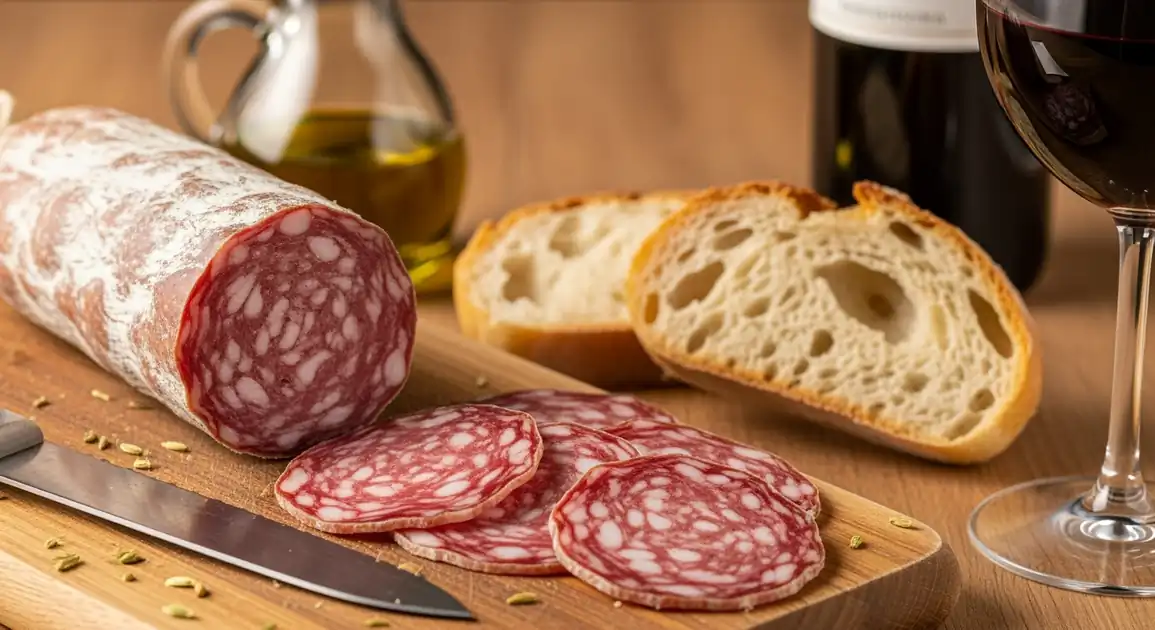Finocchiona
Finocchiona

Description
Florence (Firenze), the capital of Tuscany, is a center of excellence for finocchiona production and consumption. Here, this aromatic salami can be found in countless salumerie, markets, and restaurants, often made by artisans following centuries-old family recipes. Florence's location in central Tuscany places it at the heart of the designated IGP production zone, making it an ideal place to experience authentic finocchiona.
Dietary Information
Serving information
Serving style
In Florence, finocchiona is typically served thinly sliced on wooden boards, often accompanied by local pecorino cheese and unsalted Tuscan bread ('pane toscano'). In wine bars and restaurants, it's commonly part of an 'antipasto toscano' or 'tagliere di salumi' (charcuterie board).
Quick facts
Markets: 7 AM - 2 PM (closed Sundays). Food shops: typically 8 AM - 1:30 PM and 4 PM - 7:30 PM (closed Sunday, often Monday morning).
Safety Tips
What to Look For
-
IGP certification (Indicazione Geografica Protetta)
This designation guarantees the salami has been produced according to traditional methods in the specific geographic region of Tuscany, ensuring quality and safety standards.
-
Clean, consistent appearance without discoloration
The meat should be ruby-red to burgundy with white fat marbling. Avoid products with green, gray, or unusually dark spots, which may indicate spoilage.
-
Pleasant, fennel-dominant aroma
Fresh finocchiona should smell aromatic with prominent fennel notes. Any sour, ammonia-like, or rancid odors indicate the product has spoiled.
-
Purchased from reputable vendors
Buy from established salumerie, market vendors specializing in cured meats, or directly from producers who can verify their production methods and ingredients.
What to avoid
-
Yellowish or gray fat
Discolored fat indicates oxidation and potential rancidity. Fresh finocchiona should have white, clean-looking fat.
-
Sticky or slimy surface
A slimy texture indicates bacterial growth and spoilage. The surface should be dry to slightly moist but never sticky.
-
Unusually cheap finocchiona
Authentic quality finocchiona requires good meat, proper aging, and skilled craftsmanship. Suspiciously low-priced products may use inferior ingredients or improper processes.
-
Excessive mold beyond white powdery coating
While some white powdery mold is normal on the casing (and safe), green, black, or excessive mold growth indicates improper aging or storage.
Price information
Price range
Budget tips
- Avoid touristy shops near major attractions like the Duomo or Ponte Vecchio, which often charge premium prices.
- The Sant'Ambrogio market generally offers better value than the more famous Mercato Centrale.
- Small neighborhood shops outside the historic center often offer better prices than those in heavily touristed areas.
- Ask for smaller quantities (100g) to sample different producers without spending too much.
Value indicators
- IGP certification label visible on the product or mentioned by the vendor.
- Shops that age their own salumi or have direct relationships with small producers.
- Hand-tied with visible natural casing rather than uniform machine production.
- Shops where locals are shopping (always a good sign).
- Vendor knowledge about aging time and production methods.
Where to Find This Dish
Mercato Centrale
The iconic two-story market in San Lorenzo area houses several quality vendors selling finocchiona, particularly on the ground floor dedicated to fresh products.
San Lorenzo Church, Via dell'Ariento
Morning (8 AM - 12 PM)
Sant'Ambrogio Market
A more local market with excellent salumi vendors and generally better prices than the more touristy Mercato Centrale.
Piazza Ghiberti, Sant'Ambrogio Church
Morning (7:30 AM - 12:30 PM)
Oltrarno
The area 'across the Arno' has many small, authentic food shops catering more to locals than tourists.
Palazzo Pitti, Santo Spirito
Morning (9 AM - 1 PM), Afternoon (4 PM - 7 PM)
Historic Center Shops
Several historic salumerie and gastronomie in the city center offer premium quality products.
Via dei Neri, Via de' Tornabuoni
Midday (10 AM - 1 PM), Afternoon (4 PM - 7 PM)
Vendor Tips
- Ask for 'finocchiona IGP' specifically to ensure you're getting the protected designation product.
- Quality vendors in Florence will proudly tell you about their producers and aging methods.
- Look for shops where they slice the finocchiona to order rather than pre-sliced versions.
- If you speak limited Italian, shops in Florence are accustomed to foreign visitors and many vendors speak some English.
How to Order
Regional Variations
-
Sbriciolona Fiorentina
(Sbriciolona Fiorentina)
A Florence specialty that's a softer, more crumbly version of finocchiona, typically aged for a shorter period. The texture is more delicate, almost spreadable on bread.
-
Finocchiona Piccola
(Finocchiona Piccola)
Small-diameter finocchiona (about 10-15cm circumference) that's popular in Florence and aging more quickly, offering a slightly different texture profile than larger versions.
Cultural context
History
Finocchiona's origins date back to the Middle Ages in Tuscany, where fennel seeds were cleverly used to mask the flavor of pork that wasn't perfectly fresh, as fennel grew abundantly in the Tuscan countryside. Legend claims that a thief at a fair near Prato stole a salami and hid it in a fennel field, accidentally creating the first finocchiona when the meat absorbed the herb's flavor. By the Renaissance, it had become a valued delicacy, even mentioned in Boccaccio's Decameron. In 2015, it received IGP status, protecting its traditional production methods.
Local significance
In Florence, finocchiona represents the city's proud culinary heritage and connection to the surrounding Tuscan countryside. It embodies the Florentine appreciation for high-quality artisanal food products.
Eating customs
- Florentines typically enjoy finocchiona with unsalted Tuscan bread, allowing the flavor of the salami to shine.
- Sometimes rubbing the bread with a little olive oil ('fettunta') before adding the finocchiona.
- Often accompanied by a glass of Chianti, whose acidity balances the richness of the salami.